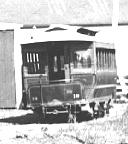
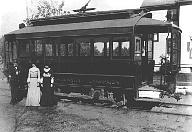
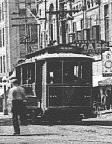
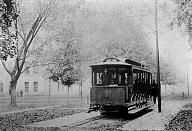
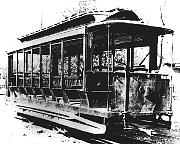
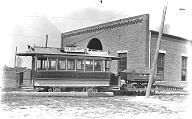
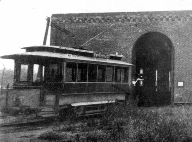

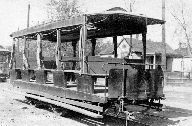
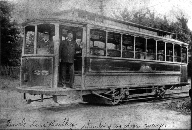
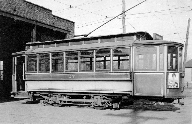
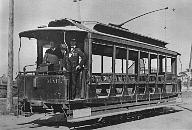
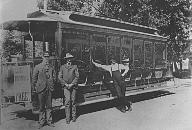
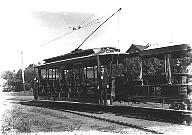

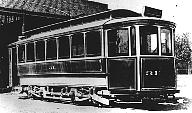



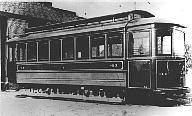
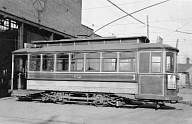
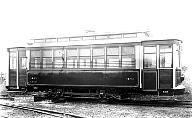
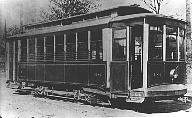
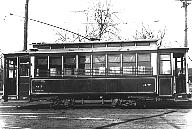

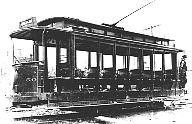

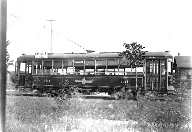
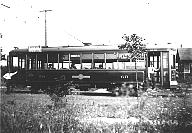
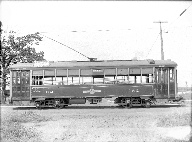
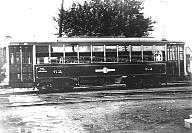
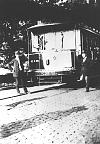
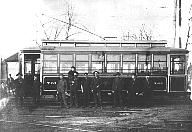
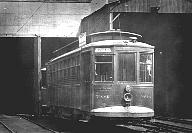
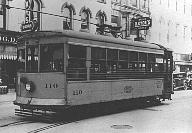
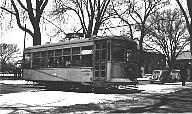

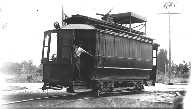
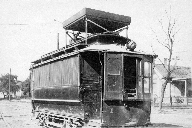
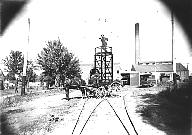
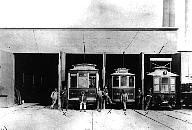

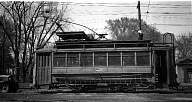
This chapter has four parts:
Part A. City Cars (immediately below)
Part B. Early ITS Cars
Part C. K&UT Cars
Part D. University of Illinois Test Car
Compiled by James J. Buckley and H. George Friedman, Jr. Research into
the J. G. Brill Co. records by Harold E. Cox is gratefully acknowledged.
| Car # | Type | Built | Builder (Order No.) | Truck (Order No.) | Notes | Pictures |
|---|---|---|---|---|---|---|
| Passenger cars: | ||||||
| 10-11 | ST Closed Motor | 1890 | Brownell | Brill 7 (#3071) | 16', 7 window | 14A-1, 14A-2, 14A-3, 14A-33 |
| 12 | ST Open Motor | 1891 | Brownell | Brill 7 (#3071) | 20', 8 bench | 14A-4, 14A-5 |
| 13-14 | ST Closed Motor | 1891 | Brownell | Brill 7 (#3421) | 16', 8 window | 14A-6 |
| 15 | ST Open Motor | 1891 | Brownell | Brill 7 (#3421) | 20', 8 bench | |
| 16-17 | ST Closed Motor | 1892 | LaClede (#294) | Brill 13 or McGuire | 20', 7 window | 14A-7, 14A-7.5 |
| 18-20 | ST Closed Trailer | 1893 | Brownell | Brill 21E? | 16' | |
| 21-23 | ST Open Trailer | 1893 | 14A-33 | |||
| 24 | ST Open Trailer | 1894 | ex horsecar? | 14A-7.8, 14A-11, 14A-12 | ||
| 25 | ST Closed Motor | American? | 8 window | 14A-8 | ||
| 26 | ST Closed Motor | American? | ||||
| 27 | ST Closed Motor | American? | 7 window | 14A-8.5 | ||
| 28-29 | ST Open Motor | Brownell? | 8 bench | 14A-9, 14A-10, 14A-11, 14A-12 | ||
| 30 | ST Closed Motor | |||||
| 31-32 | ST Closed Motor | 1900 | Brill (#10153) | Brill 21E | 7 window | 14A-13 |
| 33-38 | ST Closed Motor | American? | Brill 21E | 8 window | 14A-14, 14A-34, 14A-35 | |
| 39-41 | ST Closed Motor | 1905 | American (#575) | Brill 21E | 32', 8 window | 14A-15, 14A-16, 14A-17 |
| 42-43 | ST Closed Motor | 1905-06 | American? | Brill 21E | 31', 7 window | 14A-17.5, 14A-35, 14A-36 |
| 44 | ST Closed Motor | 1906 | American? | Brill 21E | 32' | |
| 45-47 | ST Closed Motor | 1909 | Danville (#521) | Brill 21E | 33', 8 window | 14A-18 through 14A-21, 14A-34 |
| 48 | ST Closed Motor | Brill 21E | 32' | |||
| 49 | This number may have been unused. | |||||
| 50-51 | ST Open Motor | 1902 | Stephenson | 10 bench | 14A-22, 14A-23 | |
| 52-59 | These numbers were probably not used. | |||||
| 60-62 | DT Closed Motor | 1912 | St. Louis (#953) | St. L. 99B | 41', 10 window | 14A-24, 14A-24.5, 14A-25, 14A-25.5 |
| 101-106 | ST Birney | 1920 | American (#1238) | Brill 79E1 | 27'8" | |
| 107-115 | ST Birney | 1922 | American (#1315) | Brill 79E1 | 28' | 14A-29 |
| 116-120 | ST Birney | 1924 | American (#1390) | Brill 79E1 | 27'8" | 14A-30, 14A-31 |
| 600s | ST Open Motors | 1902 | St. Louis (#244) | DuPont 46 | 35', 12 bench | 14A-26 |
| 700s | ST Closed Motors | 1908 | Danville | 33' | 14A-27, 14A-28 | |
| Work cars: | ||||||
| 1 | ST Line car | 4 window | 14A-32, 14A-32.5, 14A-34 | |||
| 2 | Horse drawn tower wagon | 14A-33 | ||||
| 5 | ST Sand/coal | 14A-6 | ||||
| 100 | ST Sweeper | 1917 | McGuire-Cummings | McGuire | 28' | |
| 200 | ST Work | Brill 21E | 33' | |||
| 205-206 | Side Dump Coal Trailers | St. Louis | 32' | |||
| 207 | DT Cab on Flat | 1902 | Co. shops | Peckham | 14A-35 | |
Notes: Body lengths quoted for #10-38 are without platforms. Beginning with #39, platforms are included in the length.
#2: Tower wagon #2 was authorized by the Champaign city council on May 28, 1901. But it is known in a photograph that seems to be from the 1890s.
#10-15: Westinghouse 3 SRG motors on Brill 7 trucks. Brill truck order #3071 was for three trucks; truck order #3421 was for one more. These four trucks appear to have been used on closed cars 10, 11, 13, and 14 in winter, with two trucks moved to open cars 12 and 15 in the summer.
#16-17: One report says McGuire trucks. But two Brill 13 trucks were ordered April 12, 1892, and must have been for these two cars.
#25-27: 2nd hand from Cleveland, 1896. These cars were similar to one another, but not identical.
#33-38: 2nd hand from Cleveland, 1/1900.
#41: Later had St. Louis 46 truck.
#42: Converted to line car (also see photo in Trolley Sparks for November 1954, CERA Bulletin 98, page 68).
#60-62: Sold 1/1925 to Chicago Ottawa & Peoria #108-110 for LaSalle-Peru.
#101-120: The order numbers shown for the Champaign-Urbana Birney cars are those given by Harold Cox in The Birney Car. Those records indicate that order #1238 was originally for Decatur, but was diverted to Champaign-Urbana, and that the order was completed in May 1920. According to news stories in the Urbana Courier of May 27, 1920 and the Champaign News-Gazette of May 29, 1920, the first Birney cars were delivered to Champaign-Urbana the morning of May 28, 1920, and were tested that afternoon. The newspapers report that they went into service June 6, 1920 on the Church Street line and the Short Line. However, Paul Stringham, in his book 76 Years of Peoria Street Cars, states that the first 20 Birneys in Peoria, their numbers 400-419 (American Car Co. order #1264, 1921), were in 1923 repainted and renumbered to 100-119 “for distribution to other I. P. & L. properties, some kept in Champaign.” His book contains a 1923 photo of cars 113 and 114 of this group, in front of the North Adams Street car barn in Peoria. Stringham lived in Peoria during this period, and his information is probably accurate. ITS and IP&L often moved cars around among the city properties, and it is more than possible that our records of these moves are incomplete. This author speculates that the ex-Peoria cars were all distributed from Champaign-Urbana to “other I. P. & L. properties,” and that none were “kept in Champaign.”
#101,102,104,106: To IP&L Cairo #107,105,106,108 12/1927.
#107,111: To IP&L Jacksonville #107,111 1927.
#103,105,108-110,112-114 supposedly became IP&L Peoria #500-507 in 1930 for use in owl service there. However, a 1936 last-day (November 10, 1936) photo in downtown Champaign depicts #110, and Charles Gammel of Danville has stated that he rode #112 in Champaign on September 19, 1936. Except for #113, for which there is evidence of transfer to Peoria, we do not really know which Champaign-Urbana Birneys became Peoria #500-507.
600s: #613, 615, 616, 623, 641, 652, 666, 698 2nd hand from United Rys. of St. Louis, 1905. Operated in Urbana-Champaign with St. Louis numbers. Had St. Louis 38 trucks as built.
700s: Leased from Illinois Traction System. In 1908, ITS received an order of single truck cars from the Danville Car Co., cars 700-709. Car 700 was eventually renumbered 710. According to local newspapers, the first of this group arrived in Urbana-Champaign January 4, 1908. #701, 702, 704, 707 are known in Urbana-Champaign. #707 eventually demotorized and used as a trailer. Cars #700, 708, 709, and 710 are known to have operated in Danville. #702 and 703 are known in Bloomington-Normal. #704, 706, 707, and 710 are known in Decatur. This list of assignments is obviously incomplete.
Abbreviations:
DT: Double truck
IP&L: Illinois Power & Light Co.
ITS: Illinois Traction System
ST: Single truck
St. L.: St. Louis Car Co.
UC: Urbana-Champaign
Car numbering:
In the beginning, the horsecars were simply numbered consecutively
from no. 1. It is not known how many horsecars were eventually on
the property, but almost certainly, there were fewer than 10. When
electric passenger cars began to arrive in 1890, they were numbered consecutively
beginning with 10, without regard for motor or trailer, closed or open.
Eventually, when two open cars arrived in 1902, someone seems to have decided
to number them in a separate series from the closed cars, and they were
assigned the numbers 50 and 51. Again in 1912, the three double truck
cars were numbered in the 60s, presumably to set them apart. The
600s, second-hand from St. Louis, were operated with their St. Louis numbers.
The 700s belonged to the ITS, and their numbers make sense in the early
ITS numbering. Finally, the Birney cars were numbered beginning with
no. 101.
Work cars were treated differently. In the early 1890s, they
were given single-digit numbers, no longer needed for horsecars.
Numbers 1, 2, and 5 are known; presumably there must have been at least
a #3 and 4, but no information is available.
Later, the sweeper was given #100, and other work cars were numbered
in the 200s.
|
|
|
| Pictures of Passenger Cars | |
| Picture 14A-1. | |
 |
Car no. 10 was the first electric streetcar in Champaign-Urbana, entering service in October 1890 when the electric route opened between Hill and Neil Streets in downtown Champaign, and Wright and Green Streets at the University. Cars 10 and 11 were 16 foot 7 window closed cars built by the Brownell Car Co. in 1890. This picture, taken from the background of a larger view, shows car 10 in its original configuration, with open platforms and a Bombay roof. — Champaign County Historical Society (detail from #240 lower) (This is the same picture as Picture 3-1.) |
| Picture 14A-2. | |
 |
Car no. 11 was the second electric streetcar in Champaign-Urbana. Cars 10 and 11 were 16 foot closed cars built by Brownell in 1890. No. 11 went into service on March 13, 1891, when the private right-of-way in Urbana was electrified. In the 1890s, it was sometimes used as a line car by fitting a platform over the roof. Note the unusual position of the brake handle: on the platform, rather than over the dash. This was probably made necessary when the add-on vestibule windows, seen here, were installed. The car was overhauled in 1897, receiving a more powerful motor, a new paint scheme, and vestibules. Compare the two pictures of sister car no. 10: Picture 14A-1 above is older, and Picture 14A-3 below is newer. Car 11 was probably retired after a fogbound collision with ITS interurban car no. 300 on West John Street the evening of March 5, 1908. The conductor is wearing his bell punch, the fare counting device hanging from his neck. Look at those long dresses! — Champaign County Historical Society (#235 lower) |
| Picture 14A-3. | |
 |
Car 10 is seen here after an extensive rebuild added permanent vestibules to the original 16 foot body. Even the roof line has been changed, with a full clerestory roof replacing the original Bombay roof. It is seen here in downtown Champaign, in a blow-up from a larger picture. — Champaign County Historical Society (detail from #77) |
| Pictures 14A-4 and 14A-5. | |
 |
Car no. 12 was the third electric streetcar, and the first open car, to run in Champaign-Urbana, entering service April 9, 1891. Built by Brownell, it had a 20 foot body and 5 foot platforms, seating 40 passengers on its 8 full-width benches. There was no aisle; the conductor rode the running boards to collect fares from the passengers. The upper picture shows car 12 along Green Street in the 1890s. In the lower picture, dated 1910, the car is beginning to show its age, especially on the dash. — Melissa Chambers (Harris family collection) (upper), Illinois Power Co. Archives (lower) (The upper picture is the same as Picture 3-3.) |
 |
|
| Picture 14A-6. | |
 |
Urbana and Champaign do not seem to have been superstitious about the number 13, for here is car no. 13. Cars 13 and 14 were built by Brownell in 1891, and no. 13 went into service in October, the fourth car in the growing electric fleet. It was more luxurious than its predecessors, featuring electric heating and upholstered seats for the first time in the Twin Cities. The body was the same length as that of numbers 10 and 11, but 13 and 14 each had one more window. This 1894 picture probably shows the car's original paint and equipment. The car was marked for the University, but did not carry the company name at all. At this time, it was assigned to shuttle service on the New Street line. It carried a roof board advertising “U. of I. Band Concert West End Park Saturday Night April 28,” which allows us to date the picture. The building is the Tremont Street car barn, in its original condition. Note the little work car no. 5 behind car 13. — Champaign County Historical Museum |
| Picture 14A-7. | |
 |
No. 17 and its sister car, no. 16, were acquired in 1892. They were the largest cars in Champaign-Urbana at that time. The Champaign County Gazette compared them favorably to the finest steam railroad Pullman “Palace” cars. The interiors featured solid cherry panels, brass trimmings, and upholstered seats. This picture, a detail taken from a larger photo, shows no. 17 in front of the Tremont Street car barn during the 1890s. — Melissa Chambers (Harris family collection) |
| Picture 14A-7.5. | |
 |
The art work for the sides of cars no. 16 and 17, from the LaClede paint order books. According to notations on the sheet, the main panel and belt rail were to be painted Paris green, and the “center work” and concave section were to be white. Ornaments, the broad line, and the lettering on the main panel were to be gold, there was to be no shading or edging on the ornaments, and the letters were to be edged with black. Numbers were to be “shaded two shades of purple & split with carmine”. The small lettering to the left of the ornate C says, “Ornament same as on superior”, i. e., same as the panel above. The upper panel was to have the word Illinois on the right side. Similar art work can be seen on car no. 13 in Picture 14A-6, above. — National Museum of Transport collection, courtesy of A. Bradley Martin, Jr. |
| Picture 14A-7.8. | |
 |
Trailer number 24 appears to be a leftover horsecar, still available to be pulled by electric horsepower when the crowds to be transported exceeded the capacity of the little electric motor cars. The car could easily seat about 45 or 50 people, not counting standees. This picture is dated 1910. — Illinois Power Co. Archives, courtesy of Dale Jenkins |
| Picture 14A-8. | |
 |
Neither the builder nor the date of building of car no. 25 is known, but it appears to be a typical turn-of-the-century American Car Co. product. Conductor Lem Bartley and his now-unknown motorman posed with their lady passenger, perhaps somewhere along the private right-of-way in Urbana. Route signs were still a thing of the future, but ornate scrollwork was still painted on the side of each car. |
| Picture 14A-8.5. | |
 |
Car no. 27 is spotted outside the Hickory St. car barn. Cars 25-27 were second hand from Cleveland, Ohio, where they were presumably too small. They were probably built by Brill or American Car Co. Notice the similarity to car 31, seen in a 1910 photo below (Picture 14A-13). The ad on the dash of the car is for an attraction at the Illinois Theater in Urbana on Friday December 30. December 30 was a Friday in 1910 and next in 1921. The picture was probably one of a series taken just before the cars were modifed for Pay As You Enter (PAYE) operation in 1910. These changes included new sliding doors at the right front, replacing the windowed solid panel seen here. — Illinois Power Co. Archives, courtesy of Dale Jenkins |
| Pictures 14A-9 and 14A-10. | |
 |
Car no. 28 was an 8-bench, no-aisle open car, perhaps dating from the late 1890s. Note how there are no passenger seats on the motorman's platform. The company was reported to have begun installing fare registers on the cars in September 1891, but these conductors are wearing bell punches. The "MAIL" sign on the dash announces the fact that, beginning August 5, 1891, sacks of mail were carried on the regular cars between Champaign and Urbana. Although the company name did not appear on the cars, the letterboard was marked “Urbana University Champaign,” which was the standard for many years. — Champaign County Historical Society, from Urbana Courier archives (Picture 14A-9 from #234 lower, Picture 14A-10 from #235 upper) |
 |
|
| Pictures 14A-11 and 14A-12. | |
 |
In the upper picture, car no. 28 leaves the barn with a trailer in tow, perhaps for service to West End Park or to the Fair Grounds. The number of the trailer is not visible, but it might have been a former horsecar and it was probably one of the 21 to 24 group. The scene is at Tremont Street, in the yard outside the car barn, looking northwest. Notice the lack of a frog in the overhead wire at this switch. It was the conductor's job to make sure the trolley pole did not leave the wire as the car passed over the switch. In the lower picture, open car no. 29, sister to car 28, poses in front of the original Tremont Street car barn. Trailer no. 24 sits in one door of the two-track “annex” built onto the south side of the barn. — Champaign County Historical Society, from Urbana Courier archives (upper), Don T. Thrall photo, William C. Janssen collection (lower) |
|
|
|
| Pictures 14A-13 and 14A-13.5. | |
 |
Cars no. 31 and 32 were built by Brill in 1900 on order #10153, and were delivered in August. Each car seated 40 passengers. They were delivered as open platform cars, a typical configuration in 1900. The upper photo shows the first attempt to enclose the vestibule, at least partially; there were still no doors at the top of the steps. This is probably the condition of the car around 1905 or so. Note the gleaming paint on the curved side, literally a mirror finish. In the second photo, from 1910, the vestibules have been completely enclosed with no right-front door, and a roof-mounted route sign has been added. Compare to car no. 27 in Picture 14A-8.5. — Illinois Power Co. Archives (lower photo) |
 |
|
| Picture 14A-14. | |
 |
Cars no. 33-38 were acquired second hand from Cleveland, Ohio, probably between 1902 and 1904. They appear to have been built by Brill or American Car Co., possibly around 1902. The 6 cars comprised the largest single car order for the system at that time. They were a little longer than the 1900 cars, no. 31-32. Here, we see no. 33 somewhere in Urbana as Mrs. Jessie Freeman Campbell collected for a charity fund drive, perhaps the annual “Trolley Day” held to benefit Burnham Hospital. — Champaign County Historical Society (#239 lower) |
| Pictures 14A-15 and 14A-16. | |
 |
Cars no. 39-41 were built by American Car Co. in late 1904 on order #575. Car 41 is seen here in its builder's photos, as publicized in Street Railway Journal. The three cars were all in service in Champaign-Urbana by the end of February 1905. The upper picture shows car no. 41 on its original Brill 21-E trucks. The lower picture shows the off-center bulkhead door. This was the patented Brownell Semi-Accelerator arrangement, designed to speed loading and unloading of passengers in this pre-Pay As You Enter car. (That means that after a passenger boarded the car, the conductor was responsible for going to him or her and collecting the fare.) The interior was finished in cherry, with a birch ceiling tinted light green. Note the longitudinal seating, which was typical of streetcars until a few years later. — Street Railway Journal, 1905, v. 25, p. 449. |
 |
|
| Picture 14A-17. | |
 |
A 1910 view of car no. 41 in front of the Hickory Street car barn. The car has a different truck: a St. Louis 46/Dupont 3 truck has replaced the original Brill 21-E. Compare the truck in the builder's photos in Picture 14A-15, above. Also, compare the vestibule window to that of car no. 31 in Picture 14A-13, taken at the same time and place as this picture. In 1910, after this picture had been taken, several cars, including this one, were converted to Pay As You Enter by installing new right-front doors so that passengers could exit at the front of the car. — Illinois Power Co. Archives |
| Picture 14A-17.5. | |
 |
Cars 42 and 43 were probably built by American Car Co. in 1905 or 1906. They were a little shorter than cars 39-41, having 7 windows instead of 8. Car no. 42 is seen here in front of the Hickory St. car barn in another of the 1910 pictures taken just before modification for PAYE operation. Compare the vestibule windows, here a pair, with the configurations of cars 31 and 41 in previous pictures. — Illinois Power Co. Archives, courtesy of Dale Jenkins |
| Pictures 14A-18 through 14A-21. | |
 |
Cars no. 45-47 were the first PAYE cars designed as such to run in Champaign-Urbana. They were built by the Danville Car Co. on order #521 in 1909, and the first two were delivered November 8. They immediately went into service on the Oregon Street line, whose route sign is displayed in the second picture here; it had been inaugurated earlier the same year. The top picture is the builder's photo of car no. 46. The markings near the back door of car 47 in the third and fourth pictures read: “PAY AS YOU ENTER/HAVE EXACT FARE READY/47/U. & C. RY”. The Champaign News described these cars as “battleship” cars because of their steel-sheathed sides. These cars held several other “firsts” as well: they were the first Champaign-Urbana cars to be equipped with lever-operated front doors, and probably also the first to have HB Lifeguard fenders. These fenders were adopted in 1910 as standard equipment on all ITS city cars. Note the lighter paint scheme in the first and third pictures, compared to the second and fourth. — Danville Car Co. (top), Illinois Power Co. Archives (upper middle), Don T. Thrall photo, William C. Janssen collection (lower middle), William C. Janssen collection (bottom) |
 |
|
 |
|
 |
|
| Pictures 14A-22 and 14A-23. | |
 |
Cars no. 50 and 51 are believed to have been built by Stephenson in 1902, and delivered to Champaign-Urbana in 1903. These ten-bench open cars had a center aisle, taking up one seat per bench. So the cars seated 40 rather than 50, but gave the conductor much greater safety than the older open cars, which required him to ride the running boards. The upper view, showing no. 50, was taken in 1910. The car is signed for the Church & John branches of the main line. The lower picture, showing car 51, was taken in 1912 on W. Church Street in Champaign. The car is signed for the New and John Street branches of the main line. The original picture caption identifies the motorman as Ed Hall and the conductor as Elmer Baker, but based on other photographs of these men, this is believed to be reversed. Note the unusual roof-mounted bell. — Illinois Power Co. Archives (Picture 14A-22), Champaign County Historical Society, from Urbana Courier archives (#234 upper) (Picture 14A-23) |
 |
|
| Pictures 14A-24, 14A-24.5, 14A-25, and 14A-25.5 | |
 |
Cars no. 60-62 were built by St. Louis Car Co. in 1912 on order #953. The first and only double-truck city cars in Champaign-Urbana, they were 41 feet long and rode on St. Louis 99B trucks. Despite their length, they each had only a single trolley pole. Note the roof-mounted gongs. Car 60 is seen in the upper two pictures, and car 62 in the two lower photos. The two pictures of car 60 were obviously taken at the same location, perhaps just a few minutes apart, possibly by the same photographer. Both cars are marked for Church St. on the off-center side route sign. The unusual instruction “Pay After Entering” can be seen near the rear door in some of these photos, implying that some cars in the city fleet used the Pay As You Enter system, but that these cars do not. Since PAYE was adopted around 1910, that suggests that the photos were taken not long after these cars were built in 1912, though one wonders why they weren't built for PAYE fare collection. The logo in the center of the side panel is the same shape as the parent ITS system logo, but has the words Champaign and Urbana in its wings, with the intertwined letters C and U in the center. — Don T. Thrall photos, William C. Janssen collection (second and fourth photos) |
 |
|
 |
|
 |
|
| Picture 14A-26. | |
 |
Open car no. 616, some time in the late 'teens or early 20s. The system owned several second-hand 12-bench open cars numbered in the 600s, built by St. Louis Car Co. in 1902 on order #244 for St. Louis Transit Co. (later United Rys. Co. of St. Louis). Known in Champaign-Urbana are no. 613, 615, 616, 623, 641, 652, 666, and 698, but other members of the group may also have rolled in the Twin Cities. The route sign of this car, in shadow, says “New &” something; it was assigned to the New Street branch of the main line. The conductor, at left, is probably Roy Mount. — Roy Mount collection |
| Pictures 14A-27 and 14A-28. | |
 |
In 1908, the Danville Car Co. built a group of closed cars numbered in the 700s for the ITS, which assigned them as needed to the various city systems it owned. No. 701 was assigned to Champaign-Urbana, and was the first steel-sided city car in the Twin Cities. It was probably also the first car in the community to have air brakes, and the first to have roll signs in a vestibule window rather than on the car roof. These cars were also the last single-truck non-Pay As You Enter cars in the Urbana-Champaign fleet. The upper picture shows the car in its original configuration; note the lack of a right front door. It is shown in the lower picture in 1921 in front of the Neil Street car barn after having been rebuilt for Pay As You Enter service, with the addition of a right front door and a dash sign saying “Have Exact Fare Ready/Pay As You Enter.” Note the home made black-on-white “Owl Car” destination sign. — Illinois Power Co. Archives (lower) (detail from a larger picture) |
 |
|
| Picture 14A-29. | |
 |
Cars no. 107-115 were the second group of Birney cars in Champaign-Urbana. They were built in 1922 by American Car Co. on order #1315, and delivered in November. No. 110 is seen here on Main Street in Champaign, about to turn south onto Neil Street to begin the return trip to Urbana on the Short Line. This picture was probably taken on the last day of streetcar service in Champaign-Urbana, November 10, 1936. About to be retired, no. 110 is showing its age; note the deterioration of the roof over the front vestibule. — Champaign County Historical Society (#238 lower), from Champaign News-Gazette archives |
| Picture 14A-30. | |
 |
The third group of Birney cars in Champaign-Urbana, no. 116-120, was built by American Car Co. on order #1390 in 1924. These were the last new streetcars ever in Champaign-Urbana. The group is represented here by no. 116 on the Short Line as it crosses Burrill Avenue on the University of Illinois campus on the private right-of-way, eastbound for downtown Urbana. The Men's Old Gym (now Kenny Gym) and the Old Armory (now Kenny Gym Annex) are in the background. This picture was taken April 18, 1936, just a few months before the end of streetcar service. — R. V. Mehlenbeck photo. |
| Picture 14A-31. | |
 |
Birney car no. 119 passes the company offices and the Illinois Terminal interurban depot on East University Avenue in downtown Champaign. The car is eastbound on the Short Line, having just begun its run toward Urbana, in this 1935 photo. — R. V. Mehlenbeck photo. |
| Pictures of Work Cars | |
| Pictures 14A-32 and 14A-32.5. | |
 |
Line car no. 1 was apparently created from an early electric car, or perhaps a horsecar. Note the vestibule windows, obviously not original equipment; the old-fashioned roof-mounted headlight; and the boarded-up side windows. — Champaign County Historical Society, W. T. Burnett archive (upper); Illinois Power Co. Archives, courtesy of Dale Jenkins (lower) |
 |
|
| Picture 14A-33. | |
 |
Tower wagon no. 2 is seen at the Tremont Street car barn in this eastward-looking view, probably in the 1890s. The wagon is adorned with the company name, “U. & C. Electric St. Ry. Co.” Note the bravado of the lineman on top of the tower, leaning on the live 600 volt trolley wire! He knows it's safe because he's not grounded, but how many of his friends and relatives understand that? The original barn has been extended to the south. Car no. 21, one of the open trailers (possibly a former horsecar), is in the door of the extension. Car no. 10 is standing in the yard to the right, probably in its original configuration. Tremont Street, in the foreground, was theoretically a public street, but was obviously used by few vehicles other than those of the street railway. — Champaign County Historical Society, from Urbana Courier archives |
| Picture 14A-34. | |
 |
Cars of three generations pose with some of the men who worked on them. Car no. 47, at the left, dates from 1909; no. 33, center, dates from about 1902; and tower car no. 1, right, from the 1890s. No. 1 sports archaic add-on vestibule windows and a roof-mounted headlight. No. 33 has a roof-mounted route sign, while no. 47 has its route sign in a vestibule window. Notice also how no. 47 has a larger, wider body and clerestory roof. The men marked X are, left to right: John Key, Ora Patterson, Walter Hall, and Charley Bartley. |
| Picture 14A-35. | |
 |
Track no. 4 to this car barn is being installed or replaced. Car no. 33, at the left, and no. 42, in the center, are both American or Brill Car Co. products, built just a few years apart (about 1902 and about 1906, respectively). No. 33 is signed for the Neil Street line, which provided local service on the ITS interurban tracks from the city limits on W. John Street to the Wabash tracks on N. Neil. No. 42 is signed for the New & John branches of the main line, meaning that its western terminus was at Green and Prospect on the New Street route, and that it used E. John to get to the University campus before going to downtown Urbana. The cab-on-flat work motor at the far right was probably no. 207, which was built in the company shops about 1902. — Don T. Thrall photo, William C. Janssen collection |
| Picture 14A-36. | |
 |
Work cars were often created from old passenger cars, sometimes even retaining their original numbers. Here is car 42 after the addition of a roof platform for use as a tower car and general utility car. Note the ladder carried along the side of the car. The vestibule at the left is sagging noticeably; the two pairs of doors at the left no longer hang at the same height above the rails. The location of this picture is uncertain, but it seems likely to have been somewhere in the area of the car barns on N. Hickory Street in Champaign. — Stephen Scalzo collection |
| Early car numbering system on ITS | Pictures | |
|---|---|---|
| 100s | Earliest cars, apparently numbered in sequence with Danville city car numbers | 14B-1, 14B-2, 14B-3 |
| 200s | Main line DC cars | 14B-4, 14B-5, 14B-6 |
| 300s | Branch line and suburban cars | 14B-7, 14B-8, 14B-9 |
| 350s | Main line AC/DC cars | 14B-10 |
| 400s | Branch line and suburban cars | |
| 500s | Passenger trailers | |
| 600s | Express trailers | |
| 700s | ST city streetcars (see Part A, above) | 14A-27, 14A-28 |
| 800s | DT city streetcars (in Peoria, Decatur, and Danville, at least); also possibly work cars (cranes 830 and 854 are known) | |
| 900s | Bridge cars (St. Louis suburban) | 14B-11 |
| 1000s | Express trailers | 14B-12 |
| 1050s | Express motors | |
| 1100s | Express/freight trailers: box cars with radial couplers | 14B-13 |
| 1200s | Express motors with passenger compartments | |
| 1300s | ||
| 1400s | ||
| 1500s | Pull motors | |
| 1550s | Locomotives | 14B-14, 14B-15, 14B-16 |
| 1600s | ||
| 1700s | Line cars | 14B-17 |
| 1800s | Refrigerator cars with radial couplers | 14B-18 |
Compiled by James J. Buckley, Roy G. Benedict, A. Bradley Martin, Jr., and H. George Friedman, Jr. Thanks to Larry Thomas for information on the cars from the Alton Jacksonville and Peoria.
Cars #100 and 101 were described in the Champaign County News of December 21, 1912 on the occasion of the first service to Thomasboro over the previous two days. The cars were received on December 18. They were painted dark green with mahogany trim and gold lettering, and included baggage, smoking, and “ladies'” compartments, with toilet rooms and hot water heaters. There were seats for more than 50 people, plus temporary seats that could be set up, presumably in the baggage compartment. The Electric Railway Journal gives a bit more technical detail, reporting that the cars were built by American Car Co., were 53'0" long, and ran on Brill trucks. The two cars were originally built in 1911 as part of an order of five cars, numbers 100 through 104, for the Alton Jacksonville and Peoria on American order #892. But the AJ&P had financial difficulties and was unable to take delivery of the cars, so 100 and 101 were sold to the K&UT. Later, one of these cars was renumbered 244 (the reason is unknown). The other was reported renumbered 243, but it also may have been the car which was rebuilt into a freight motor numbered 282 or 1282.
Electric Railway Journal in 1917 reported that the K&UT had taken delivery in 1916 of a 51' express motor built by Niles, and 7 wooden freight cars of 36' length. The motor was originally numbered 50, and was renumbered 1650 in 1923 (again, the reason for renumbering is not known). The motor is believed to have been second hand. The freight cars included 2 gondola cars from St. Louis Rail & Equipment Co., and 5 box cars from Interstate Car Co. Nothing more is known about the wooden freight cars.
Cars #201 and 202, a motor and trailer pair, were reportedly purchased second hand from the Wilkes Barre and Hazelton Railway in 1917. The Urbana Courier reported their arrival in Urbana in July 1917. The motor car was 51' long and 9'6" wide, weighing in at 90,000 pounds. The trailer car was 42' long, and may have been from the Dan Patch Line of Minnesota. The motor car was eventually renumbered 232.
In 1919, the K&UT began listing its equipment monthly in The Official Railway Equipment Register, a listing it maintained until the end in 1926. Roy Benedict has compiled a roster of the company's cars from those listings. However, as he points out, the company apparently did not keep its listing up to date with respect to car renumberings or other changes, and some discrepancies are to be found, even in the reported count of the cars. The dimensions reported also are not necessarily accurate. Still, this is the best information available. While it is certainly not a definitive roster, it is reproduced here, with the author's thanks.
| Car Nos. | Car Type | ORER Issue Dates Listed |
Outside Length | Inside Length | Inside Width |
Inside Height | Cubic Feet | Capacity Lbs. |
|---|---|---|---|---|---|---|---|---|
| 50 | Electric Motor | 7/19-7/23 | 54'0" | 50'0" | 8'6" | 10'4" | 2414 | 80,000 |
| 100-102 | Motor Pass. | 7/19-4/26 | ||||||
| 150 | Trailer Pass. | 7/19-4/26 | ||||||
| 200-201 | Gondola (GB) | 7/19-4/26 | 35'7" | 33'0" | 8'4" | 3'9" | 2077 | 80,000 |
| 202 | Gondola (GB) | 11/19-4/26 | 35'7" | 33'0" | 8'4" | 3'9" | 2077 | 80,000 |
| 250-258
(8 cars) | Box (XM) | 7/19-4/26 | 37'0" | 36'1" | 8'6½" | 8'1" | 2424 | 80,000 |
| 300-301 | Flat (FM) | 7/19-4/26 | 40'0" | 8'9" | * | 50,000 | ||
| 1282 | Electric Motor | 8/23-4/26 | 54'0" | 50'0" | 8'6" | 10'4" | 2414 | 80,000 |
| 1650 | Electric Motor | 8/23-4/26 | 54'0" | 50'0" | 8'6" | 10'4" | 2414 | 80,000 |
| 6050-6054
(4 cars) | Box (XM) | 10/20-4/26 | 37'0" | 36'1" | 8'6½" | 8'1" | 2424 | 60,000 |
| (1 car) | Electric Loco. | 6/19-4/26 | ||||||
| (1 car) | Electric Loco. | 8/23-4/26 |
Note that the renumbering of motor 50 to 1650 can be found in this roster. The author speculates that the Wilkes Barre and Hazelton motor and trailer cars, reported in the newspapers as originally numbered 201 and 202, became cars 102 and 150 in the roster above. The reported numbers 232, 243, 244, and 282 cannot be reconciled with this roster, yet some are known in photos of K&UT cars. The author is unable to reconcile these data.
Perhaps in an effort to reduce operating expenses by using lightweight equipment, the K&UT in 1924 placed order #1342 with the St. Louis Car Co. to purchase their lightweight demonstrator safety car, built in 1922 by St. Louis on order #1266 as their car #600 for exhibition in Chicago. This was the last and the most modern car acquired by the line. Car 242 was 42' long, weighed 36,000 pounds, and was arranged for one-man operation. It was powered by four 35 hp. Westinghouse 510-A motors, and ran on St. Louis 64 trucks. The paint scheme was Pullman green with a Venetian red roof, and passengers were carried on 22 red plush reversible seats. (This car does not seem to have been included in The Official Railway Equipment Register listings.) After the K&UT was abandoned, this was the only car to be sold for operation elsewhere. It was sold in 1930 to the Third Avenue Railway Co. of New York, where it was modified and became their #1702. In 1934, it was renumbered by Third Avenue as #1250. The car was finally retired in 1948.
In 1906, a new Railway Engineering Department was organized in the College of Engineering, which sponsored programs of study in Railway Civil Engineering, Railway Mechanical Engineering, Railway Electrical Engineering, and Railway Administration. The car was described in some detail in Street Railway Journal of June 9, 1906 (v. 27, no. 23, pp. 907-908), and the new programs of study were described in a University Bulletin which was extensively quoted in Electric Railway Review for June 15, 1907 (v. 17, no. 24, pp. 786-787).
The car was a standard double end wood sheathed interurban car, divided into two compartments. One compartment was 22'6" long and was furnished with a desk, filing cabinets, etc. to serve as a lab and office. The smaller compartment was 11'10" long and contained the equipment. The car was 44'10" long overall, 8'4" wide, 9'6" high, and was reported to weigh 55,150 pounds. It rode on Standard Steel Car Co. C-60P trucks having a wheel base of 6'4" and 33" diameter wheels, and was propelled by four 40 or 50 hp. (depending on which report was accurate) Westinghouse 101-D motors, controlled by Westinghouse AB multiple-unit controls. The control equipment that was usually mounted under the car floor was instead mounted inside the smaller compartment where its operation could be observed. The braking system was a simple straight air system, with emergency hand brakes. The car was equipped with recording voltmeters, ammeters, and wattmeters, “and with auxiliary measuring and recording devices by means of which there is automatically made a graphical record of voltage, current, power, speed, acceleration, time and [track] curvature.” It was also equipped with a pair of wire brushes attached to the inside ends of the truck frames so that they contacted the rails as the car operated down the track. A low voltage current could be passed through these brushes and the rail between them, providing a means of measuring the resistance of rail bonds as the car passed over them. The readings were recorded within the car on a continuous paper tape.
The car was operated over both ITS and K&UT lines for various testing and instructional purposes over the years. It is known to have been active at least as late as 1939 (see Picture 14D-6, below, whose date has been recorded), and was still active when trolley fan writer Stephen D. Maquire featured it in an article in his “Electric Lines” column in the April 1943 issue of Railroad Magazine (vol. 34, no. 2, pp. 134-136). The Railway Engineering Department was discontinued in 1940, with its programs of study absorbed into other Engineering departments, and the test car was once again operated by the Electrical Engineering Department. The car survived for a few more years. Various scrapping dates have been reported, as early as 1941 and as late as 1952. The most likely scrapping date is late 1944, as reported by Ira O. Baker and Everett E. King in A History of the College of Engineering of the University of Illinois 1868-1945, pp. 493-494. They state that it was scrapped at that time “because of lack of track outlet facilities”, which probably reflects the disconnection of the tracks on the UI campus from Illinois Terminal trackage.
References for this section, in addition to those cited above, include Lawrence A. Brough and James H. Graebner, From Small Town to Downtown -- A History of the Jewett Car Company 1893-1919, Indiana University Press, 2004.
Computer Science Department, University of Illinois at Urbana-Champaign, Home Page